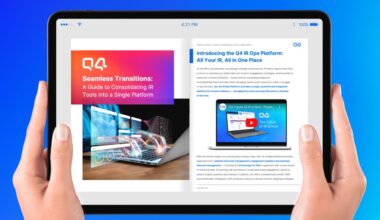Many investor relations professionals see investor targeting as one of the key components of a successful and comprehensive IR program. It has been a part of most IR-focused CRM software for at least the past 10-15 years and continues to be a subject of discussion in any forum for IR professional development. Given the changing dynamics in the investment community and capital markets globally, understanding the continued importance and evolution of investor targeting is essential for IR practitioners looking to improve the effectiveness of their outreach efforts.
Crucial importance of investor targeting
While targeting capabilities have benefited from ongoing technology improvements, investor behavior and preferences have shifted and become more diverse. This has made it even more critical for IR professionals to effectively manage the time they spend on targeting. Even a basic set of screening criteria can help IR teams focus their resources on investors who are most likely to be interested in hearing their company’s story. The traditional approach of targeting “who owns my peers but doesn’t own me” is perhaps the most challenging path to take. I compare this to wearing a Yankees jersey to Fenway Park and trying to convince Red Sox fans to switch their alliance. Suppose you are targeting an analyst or portfolio manager who analyzed your peer group and invested in a competitor. In that case, convincing them that they made a bad investment will probably be very difficult.
Ideally, your time is spent on investors who are ready to make an investment and whose financial goals align with your company’s expected performance. Additionally, many investors today are including other non-financial criteria in their investment decisions, so identifying investors who share company values and long-term strategic views will result in investors who are more likely to remain shareholders for a longer duration.
Targeting transformation
Targeting capabilities have continued to evolve with changes in financial markets and investor preferences. Ownership vs. non-ownership based screening has been enhanced with scoring mechanisms. As processing power increased, improved metrics became available to quantify the more-likely versus less-likely targets better. Larger datasets and more powerful algorithms are used to analyze a more comprehensive set of criteria, enhancing investor relations targeting analyses. The Q4 Platform is also implementing rapid advancements in the use of additional information sources to help our clients refine their target investor lists. Our Engagement Analytics capability offers IROs the potential to identify investors who are actively engaging with the company’s website, digital assets, and investor events. Users can now target institutional investors demonstrating interest in the story without contacting the company’s investor relations team. This enables the IR team to refine their messaging and outreach to the unique individual and their specific interests. Additionally, the IR team can tailor their outreach efforts to leverage the platform, channel, or medium that best suits the investor.
Substantial Benefits
For IR teams that can adopt these new approaches, this translates to a more efficient use of investor relations’ time. By leveraging technology and data-driven insights, the segmentation of targeted investors can be more precise and accurate. It also enables customized communications and a higher success rate. Leveraging a modern, comprehensive platform reduces the time spent mining data and analyzing possible scenarios. It enables investor relations professionals to spend valuable time communicating their company’s investment thesis and building relationships with long-term shareholders. It also ultimately leads to a much more effective use of company management’s time. This can be reinforced with evidence of continued investor engagement following each interaction with IR and management, rather than waiting to see if an ownership position is established months or even years later.
Looking Ahead
Investor targeting remains a foundational capability of an effective investor relations program. The significance of leveraging technological improvements and new approaches continues to increase. All IR professionals must adapt and embrace these evolving technologies to remain successful. The future of investor targeting promises even more innovation through the integration of natural language processing, tighter integrations with CRM activity tracking, calendar integrations, meeting effectiveness measurements, as well as sector & industry engagement benchmarking enhancements. If you aren’t yet utilizing some of the latest capabilities, reach out to your Q4 representative, and we can show you what’s possible. Targeting will continue to be a subject of innovation, so you must keep your targeting capabilities current. For additional insights into investor targeting, you can read “Investor targeting strategy: Five critical ways to optimize yours” or speak with one of Q4’s experts.


